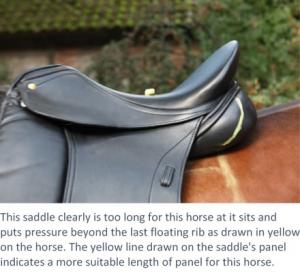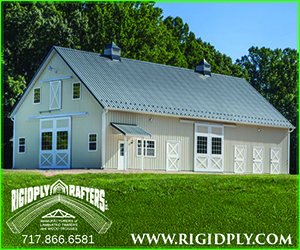A Quick Review of the 9 points of Saddle Fit
By Jochen Schleese, CMS, CSFT, CSE
©2018 Saddlefit 4 Life. All Rights Reserved
With spring coming, we need to ensure that our tack and equipment will work for the upcoming training and for the shows we intend to compete in. If your horse has been ‘off’ for the winter you will need to ensure that the saddle is fitted properly to allow him comfort and freedom to muscle up when you begin training.
A quick diagnostic can be done using our 9 points of saddle fit below (with videos available through YouTube at www.youtube.com/c/schleesesaddlery.
1. Balance
Too high in the pommel and too low in the cantle causes pressure on the horse’s back. The horse cannot engage his back because too much of your weight is on his last 2 floating ribs.
Too low in the front will pinch into the horse’s shoulder – very restrictive for your horse! Too high in the back and your leg goes forward - you fall into a chair seat to balance. This can strain the discs in your lower back. The pommel and cantle should be even. Watch Video
2. Wither Clearance
You need 2-3 fingers clearance on the top and around the side of the withers. Clearance on the sides of his withers will accommodate the shoulder rotation upwards and backwards during movement. Pinched withers = reluctance to move forward. Other signs are patches of white hairs or sores on the top or side(s) of the withers. Watch Video
3. Channel/Gullet Width
A too narrow or too wide gullet can cause permanent damage to the back. The width of each horse’s spine determines the gullet width, which must be the same from pommel to cantle. Watch Video
4. Full Panel Contact
Panels must make even contact with the back all the way to distribute the rider’s weight over the approximately 220 square inches ending at the last rib. Ensure no bridging or rocking. Watch Video
5. Billet Alignment
Billets should hang perpendicular to the ground in the girth area. Too far back and gravity will pull the billets (and the saddle) forward. The girth always finds its position at the narrowest point of the rib cage, driving the saddle onto the shoulders.
Billets too far forward into your horse’s elbow area may make him sore in the elbows. Gravity will drag them (and the girth and saddle along with them) back into the girth area, resulting in extra pressure on the panels at the rear. Watch Video
6. Length
The saddle support area (SSA) determines panel length. The saddle must sit behind the shoulder. If too long, it will get driven forward into the shoulder. The 18th thoracic vertebra is the SSA boundary. Watch Video
7. Straightness
The center of the saddle should be in alignment with your horse’s spine. Horses are by nature uneven, with mostly a larger and more developed left shoulder. The larger shoulder kicks the saddle over to the other side during motion.
An uneven rider can compress the stuffing more on one side of the saddle, pulling it over to that side. Watch Video
8. Tree Angle
The angle of the tree (at the tree points for the gullet plate) should match the angle of the horse’s shoulder. In motion, the shoulder rotates upward and backwards. The piping angle should match the shoulder angle, which means it’s correct. Watch Video
9. Tree Width
The tree width must allow horse’s shoulders to rotate freely under the tree.
If too wide, the entire saddle may rock or slip from side to side during riding, or twist to one side.
Tree width and tree angle need to be adjusted together. Adding or removing flocking from the vertical panels is not enough – the gullet plate needs adjustment. The self-adjustable gullet plates accommodate angle adjustment, but not width. Watch Video
Happy Riding!
By Jochen Schleese, CMS, CSFT, CSE
©2018 Saddlefit 4 Life. All Rights Reserved
With spring coming, we need to ensure that our tack and equipment will work for the upcoming training and for the shows we intend to compete in. If your horse has been ‘off’ for the winter you will need to ensure that the saddle is fitted properly to allow him comfort and freedom to muscle up when you begin training.
A quick diagnostic can be done using our 9 points of saddle fit below (with videos available through YouTube at www.youtube.com/c/schleesesaddlery.
1. Balance
Too high in the pommel and too low in the cantle causes pressure on the horse’s back. The horse cannot engage his back because too much of your weight is on his last 2 floating ribs.
Too low in the front will pinch into the horse’s shoulder – very restrictive for your horse! Too high in the back and your leg goes forward - you fall into a chair seat to balance. This can strain the discs in your lower back. The pommel and cantle should be even. Watch Video
2. Wither Clearance
You need 2-3 fingers clearance on the top and around the side of the withers. Clearance on the sides of his withers will accommodate the shoulder rotation upwards and backwards during movement. Pinched withers = reluctance to move forward. Other signs are patches of white hairs or sores on the top or side(s) of the withers. Watch Video
3. Channel/Gullet Width
A too narrow or too wide gullet can cause permanent damage to the back. The width of each horse’s spine determines the gullet width, which must be the same from pommel to cantle. Watch Video
4. Full Panel Contact
Panels must make even contact with the back all the way to distribute the rider’s weight over the approximately 220 square inches ending at the last rib. Ensure no bridging or rocking. Watch Video
5. Billet Alignment
Billets should hang perpendicular to the ground in the girth area. Too far back and gravity will pull the billets (and the saddle) forward. The girth always finds its position at the narrowest point of the rib cage, driving the saddle onto the shoulders.
Billets too far forward into your horse’s elbow area may make him sore in the elbows. Gravity will drag them (and the girth and saddle along with them) back into the girth area, resulting in extra pressure on the panels at the rear. Watch Video
6. Length
The saddle support area (SSA) determines panel length. The saddle must sit behind the shoulder. If too long, it will get driven forward into the shoulder. The 18th thoracic vertebra is the SSA boundary. Watch Video
7. Straightness
The center of the saddle should be in alignment with your horse’s spine. Horses are by nature uneven, with mostly a larger and more developed left shoulder. The larger shoulder kicks the saddle over to the other side during motion.
An uneven rider can compress the stuffing more on one side of the saddle, pulling it over to that side. Watch Video
8. Tree Angle
The angle of the tree (at the tree points for the gullet plate) should match the angle of the horse’s shoulder. In motion, the shoulder rotates upward and backwards. The piping angle should match the shoulder angle, which means it’s correct. Watch Video
9. Tree Width
The tree width must allow horse’s shoulders to rotate freely under the tree.
If too wide, the entire saddle may rock or slip from side to side during riding, or twist to one side.
Tree width and tree angle need to be adjusted together. Adding or removing flocking from the vertical panels is not enough – the gullet plate needs adjustment. The self-adjustable gullet plates accommodate angle adjustment, but not width. Watch Video
Happy Riding!















